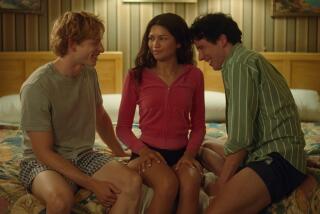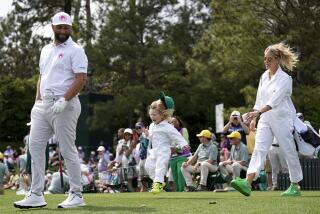Aces at Any Age : These seniors don’t just play tennis for their health. Hardly. They’re in it for the thrill of victory.
Ed Saunders steps on the tennis court looking like one of those scraggly men in the ads for Skid Row missions: His gray beard a bit unkempt, pot belly hanging out of his shorts and, on his head, an ear-flap hat.
At 73, he appears barely alive. Indeed, the issue seems in doubt during warm-up--he doesn’t even try to reach any ball that doesn’t come directly at his racket. A foot to the side, he lets it go.
But when the game begins, a transformation unfolds. As he’s about to serve, he switches the racket from his right hand to his left and sends the ball curving to the far corner of the service box--with outside spin, so it skids away from the helpless opponent.
“Fifteen love,” says Saunders, a former University of Texas player who a few years ago--before he got his artificial hip--was undefeated in Southern California’s “super senior” mixed doubles, where the man is at least 65, the woman 60.
Observers often patronize senior athletes, saying it’s cute that they’re still doing what they’re doing at 65, 75--hey, some are out there at 90. But these observers miss by a mile the true spirit of these athletes, who smile wryly when the younger set speaks again of how what’s important is the exercise, keeping the blood circulating, all that garbage.
In the dusk of life, you see, they’re liberated from the platitudes. They’re free to relish the true pleasure of competition--as the one socially acceptable way to humiliate your fellow man.
“Your serve,” Saunders says.
*
The fitness craze that hit the United States in the 1970s carried a religious fervor to it, including faith there would be medicinal benefits from, say, running five miles each morning. If exercise wasn’t viewed as the new Fountain of Youth, it was pretty darn close.
Two decades later, medical experts still are grappling to figure out the benefits of all that sweat. The New England Journal of Medicine reported a survey of 10,000 Harvard graduates, suggesting those who took up “moderately vigorous sports” in middle age lived 10 months longer than those who were sedentary.
The study, however, was based on questionnaires filled out by the participants. Physical tests have produced more modest findings.
A team of Baltimore physicians began probing “master athletes” in 1958, focusing on long-distance runners. Pounding the pavement, they found, doesn’t necessarily clear the arteries. “Our studies don’t indicate any lower evidence of cardiac disease,” says Dr. Jerome L. Fleg, a member of the team.
What is boosted by the exercise, though, is the participants’ “maximal oxygen consumption,” more commonly known as “aerobic capacity.” Whereas it declines 1% each year in most seniors, the drop is half that in the athletes.
It’s not surprising, of course, that they can keep going better than their sedate counterparts; that’s what “being in shape” means. But if they can’t have eternal life, this seems a reasonable consolation prize: the ability to perform better, to keep kicking butt.
“These guys compete,” Fleg notes. “They’re not doing it because they want to live an extra two or three years. They want to put more life in their years rather than more years in their life.”
*
Kill them. Kill them. Kill them.
Sven Davidson smiles as he explains his philosophy 40 years after he was Sweden’s star on the world tennis circuit. Now 66 and living in Arcadia, he for years terrorized players far younger--when his health permitted. He once collapsed on the court with a heart attack and was all but pronounced dead. Four months later, he was competing again.
“I think our Greek friends had it down pat 2,500 years ago,” he says, then quoting the original Greek, “A healthy mind in a healthy body.”
While there are senior leagues in many sports, from track to skiing, tennis is particularly intense because players compete not against the clock, but directly against each other. You can win not only by elevating your own game, but by making your opponent fold.
At a party during the Audi championships outside Palm Springs, players swapped stories about a 70-plus fellow from Northern California who drives a custom Cadillac with a stained glass window and who reads the Bible between games, looking for a spiritual edge.
Much of the tension in the senior ranks is generated by relative newcomers to the sport, often retired executives who seem driven to prove themselves in a new environment, preferably by knocking off a former world-class performer such as Davidson.
A prime example was the Palm Springs tournament organizer, Steve Solomon, a former college basketball player who took up tennis at 30 while a corporate vice president. “I would go out and make a list of people who wouldn’t play me because I ‘wasn’t good enough,’ ” he recalls. “I’d say to myself, ‘Next year, you’re mine.’ ”
Now he is nationally ranked in the 55-and-over doubles, competing with legends such as Pancho Gonzalez.
A Friday morning match at Solomon’s tournament, on the women’s side, featured a similar newcomer-versus-legend pairing.
The “novice” was Cathie Hall. In 1950, while bringing up two kids in Santa Monica, she watched exhibitions by a famous mother-daughter pair at Roosevelt Elementary School. They seemed like figures from some grand, lost era as they glided about the court “in their bingles and bangles and beads, and their floppy white hats.” On one side of the net was May Sutton Bundy, winner of the Wimbledon championship way back in 1905. On the other side was her daughter, Dorothy (Dodo) Cheney, winner of the Australian Open in 1938. What marvels they were!
Two decades later, Hall took up the game herself, when she moved to Newport Beach and her husband suggested they join a club as “something social to do.” Hall surprised herself with her agility, and when she reached 60, some women at the club told her there were legions of grandmas playing a senior circuit out there and that, with her power and speed, well, she might just clean up.
Soon Hall was ranked in the top 10 in the United States among women 65 and up. And whom do you suppose she was to play at Palm Valley Country Club? Cheney--edging up on 80 now but the undisputed queen of the seniors, winner of 230-plus national titles.
A realist, Hall figured that Cheney might let her win three games, to be polite, then lower the boom. But the newcomer had another thought in the back of her mind: “It’s possible.”
*
At 8:30 a.m., a Corvette pulls up to the clubhouse. The license plate reads “Dodo C.”
As Cheney makes her entrance, everyone has a word for her: The Prince racket representative wants to know what she thinks of the new equipment; Sven Davidson’s doubles partner asks if she’ll play in Europe this year; someone else asks if she’s going to be on a display court, so they can watch.
Still, this is a tough tournament for Cheney. While she’s untouchable in her own age group--75 and up--here the oldest division for women is the 65s, so she must “play down,” against opponents much younger. That can be a hurdle even for her--although no one expects a problem in the first round, not against Cathie Hall.
Cheney is a picture of elegance in her whites and large cap, almost a bonnet. She still has textbook form, moving her feet and turning her shoulder for a full, fluid backhand, the maneuver most club players never learn.
She also knows all the tricks. On the first point, she sends Hall a message--a drop shot barely over the net, with deadening backspin. Hall is frozen, helpless.
Hall looks lost for several games as Cheney keeps going to the dropper, keeping her off balance. “If you play someone like Dodo, you get psyched out,” remarks a competitor on the sidelines, Phyllis Adler, the reigning national 70-and-over indoor champion. “She’s such a legend, these other women shiver in their boots.”
But then Hall settles down. Although lacking Cheney’s backhand, her forehand is powerful and at a mere 69, she’s fast, able to run down Cheney’s softer shots. She wins a game, then another. Cheney shakes her head and takes a frustrated practice stroke. A chink in the armor.
Soon they’re even and--to everyone’s surprise--the first set goes to a tie breaker. At the crucial point, Cheney tries yet another drop shot. Hall anticipates it, and slaps the ball to the far corner for a winner. First set to the underdog!
It’s a war now. Cheney starts chipping back Hall’s serve and charging the net to pressure her younger opponent. It works well enough to win the second set 7-5.
During the 10-minute break before the deciding third set, Cheney gobbles cough drops. Hall wonders is there’s something wrong with her--or if it’s part of a psyche.
A crowd gathers for the climax. The desert sun is piercing, and some spectators toast it with $4 glasses of Chardonnay from a court-side bar. Next to it is a masseuse and his table, $1 a minute. It’s not a bad life out here.
Down the hill, sparks are flying in men’s 65 doubles. Davidson and his partner are pitted against a team that includes a zealous lawyer from Colorado who was not in their class in his youth. At a critical moment, he stares when the Swede calls his serve out.
“That’s a terrible call,” the lawyer says.
“You’re in no position to see it,” Davidson replies.
“You’re famous for it,” the lawyer snaps.
“I suggest you shut your trap.”
“I’d like you to try to make me.”
It doesn’t reach blows, but an umpire hurries to the court to keep watch. And Davidson quickly uses the episode to his advantage. He figures the lawyer will be over-eager and cut across to “poach” away his return. So he calmly hits behind the guy, at the spot he vacated.
Game, set, match.
“The battle’s the thing,” Davidson says, headed for another title.
The women 65s are back in action. When tennis honchos first contemplated play in higher age brackets, some predicted “you’ll never get enough women together who will admit their age.” They were wrong.
The final set between Hall and Cheney is nip and tuck. The key moment comes at four games each. Hall launches a stiff ground stroke at Cheney’s feet, but Cheney is ready. She lunges into the court to pick off the ball before it can land--then sends it back over the net at a sharp angle, out of Hall’s reach.
Moments later, it’s match point. Cheney draws Hall in with another deft drop shot and lobs over her head into the open court.
The legend waves to the applause from the sidelines as they meet at the net to shake hands.
“I thought I was a goner,” Cheney says, shaking her head. “These legs of mine.”
Hall shakes her head too. “Look at that last game, how I hit those balls out,” she says. “It’s time for self-examination.”
There’s hope for the future, though. Hall’s mother lived to be 89 and her dad is still up and around at 99. With those genes, she should be a force when she reaches 90-and-over play.
Davidson, however, does not expect to be killing opponents at that age. Soon after the Audi tournament, he decided that the excitement on the court posed too great a risk to his heart and gave up the racket for vigorous daily walks, “5.6 miles in 90 minutes,” he notes.
But don’t count out Ed Saunders at 90.
After his hip replacement, doctors suggested he forget tennis. He didn’t listen, of course, but--like Bo Jackson with his new hip--was easing back into competition, “saving my drop shots and spins.”
In the meantime? He was playing bridge. Competitive bridge. He’s a master of the “weak two bid.” Looks like one thing, means another. Fools ‘em, he notes . . . like that “left-hander stinker serve.”
More to Read
Go beyond the scoreboard
Get the latest on L.A.'s teams in the daily Sports Report newsletter.
You may occasionally receive promotional content from the Los Angeles Times.










